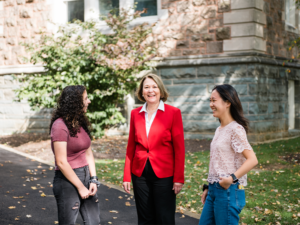Muhlenberg College this month was named an American Talent Initiative (ATI) High-Flier by Bloomberg Philanthropies, one of a group of 28 high-graduation-rate institutions nationwide recognized as leaders in college access and success for lower-income students. ATI was formed in December 2016 with a goal to attract, enroll, and graduate an additional 50,000 lower-income students at the 341 colleges and universities that consistently graduate at least 70 percent of their students in six years.
The 28 American Talent Initiative High-Flier institutions include Brown University, Princeton University, University of Chicago, University of Michigan-Ann Arbor, University of Texas-Austin, University of Wisconsin-Madison and Yale University. Muhlenberg received the distinction for the school’s steady gains in lower-income student enrollment since 2015-16, growing share of Pell Grant recipients (awarded only to undergraduate students who display exceptional financial need), and its innovative recruitment, enrollment and retention practices.
I was able to discuss these achievements with Muhlenberg College President Kathleen Harring. Click below to listen to the conversation and scroll down for some of the edited highlights:

ECN: How did the pandemic affect the way in which you approach this community? Many issues in society came up during this time—including the idea of, Diversity, Equity, and Inclusion (DEI)—and a recognition of underserved communities. Was that part and parcel of your success?
KH: Our commitment to diversity, equity, inclusion, and belonging—and the belonging piece is incredibly important—is directly related to our ATI goals. We are committed to making sure that every single student who comes to Muhlenberg feels as though they are valued, that they have a voice, that they are part of the community, that they belong. That actually has been part of our success in enrolling, but then also making sure that our students are retained and that all students are able to accept all of the amazing opportunities that we have here.
ECN: Can you share some of the secret sauce? Were there any specific kind of innovations that came about?
KH: I would say for us it was not necessarily any specific program. It was taking what we already had and aligning it very much with the needs that our current students had—in particular our lower-income and moderate-income students. And then prioritizing it. Muhlenberg’s a place where there are no silos between academic affairs, student Affairs, the Career Center, etc. And so what we did, even before the pandemic and are currently doing now, is provide much more integrated student support across academic advising across the career center, across disability services, the writing center, and so on.
We do have a program called the Emerging Leaders Program, which had been started years ago, but we recently have been able to expand. It’s a cohort program for students from underserved populations where they come in for pre-orientation somewhat earlier than the other students in their first year. And the focus is on making sure that those students know what the resources are, that those students are able to connect with one another, and also to connect with peer mentors, faculty mentors, and staff mentors.
We also have what is called the care team. The care team is a group of staff across academic affairs, student affairs, counseling, health center, the office of Disability Services, the multicultural Center, who all work together. They meet weekly in order to identify students who they are concerned about—who may need various resources. During the Pandemic, that was an important group that identified students very early on who maybe we’re having some challenges. So we were able to provide wraparound support.
ECN: What sort of recommendations would you give to our readers and to our listeners who haven’t reached those same goals. Where should they begin?
KH: The first step is to listen to their students. Part of what we did here at Muhlenberg is we paid very close attention to what our students were saying they needed. And then we actually changed how we did things in order to make sure that all students’ deeds were addressed and that they were able to access those opportunities. So listen to your students. All colleges, all university campuses are different. Realize that there are different types of students and different groups of students. Each needs to have different types of programs and different types of resources that allow them to succeed and to achieve their goals.

